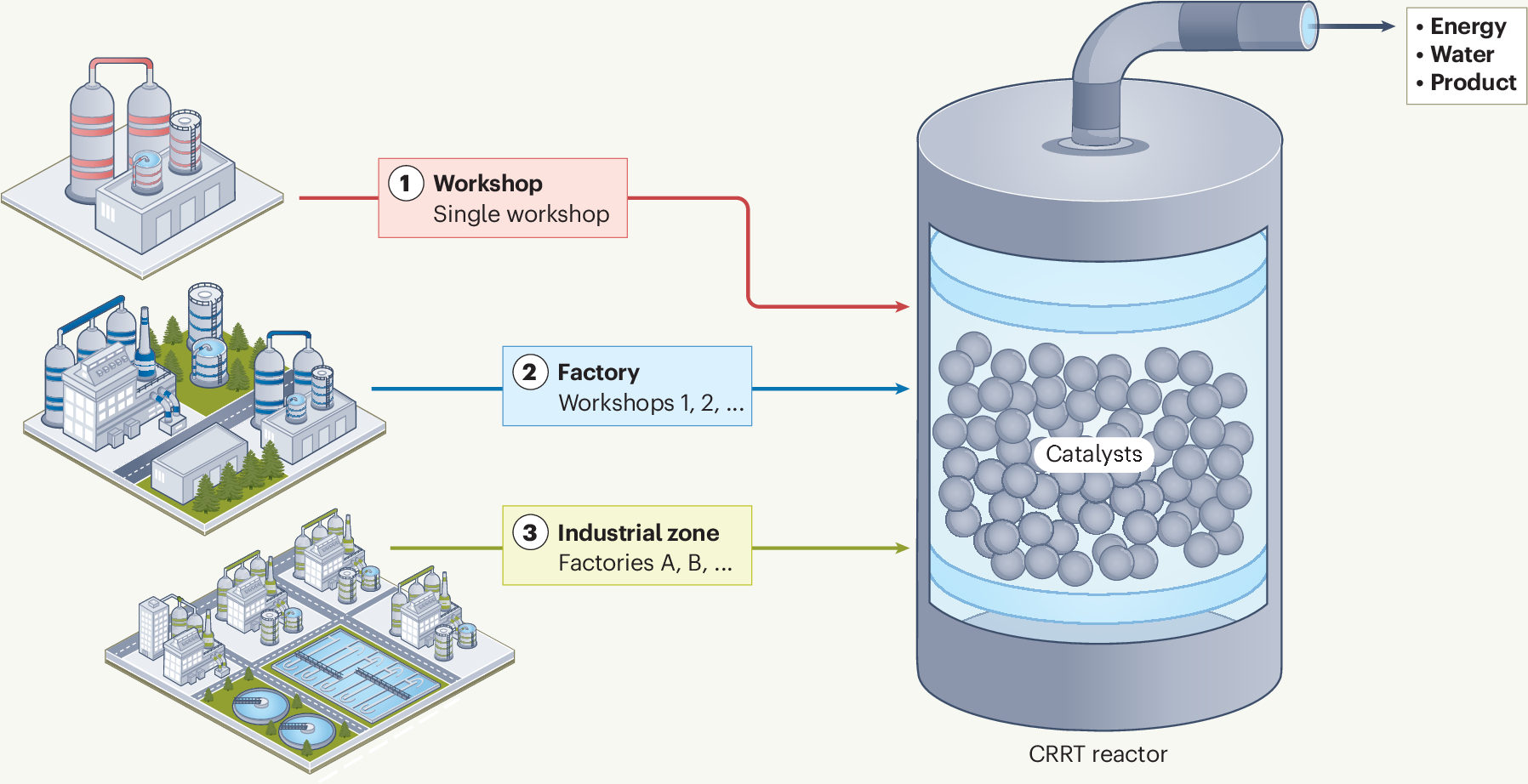Catalytic resource recovery for transformation of the wastewater industry – Nature

Report on Catalytic Resource Recovery Technologies for Sustainable Industrial Wastewater Management
1.0 Introduction: Addressing Global Water Challenges
Industrial wastewater, laden with diverse organic and inorganic contaminants, presents a significant challenge to conventional water treatment systems and poses a threat to achieving Sustainable Development Goal 6 (SDG 6: Clean Water and Sanitation). However, a paradigm shift is underway, viewing these pollutants not as waste but as valuable resources. This transition is critical for developing a circular economy, a core principle of SDG 12 (Responsible Consumption and Production). Catalytic Resource Recovery Technologies (CRRTs) are emerging as a promising solution, offering selective conversion of contaminants into value-added products. This report summarizes the function of CRRTs, proposes a strategic framework for their implementation, and evaluates their comprehensive benefits in the context of global sustainability targets.
2.0 Catalytic Resource Recovery Technologies (CRRTs)
CRRTs utilize catalytic reactions to transform pollutants, moving beyond mere remediation to active resource creation. This approach supports a closed-loop, resource-oriented strategy for industrial wastewater management, directly contributing to SDG 9 (Industry, Innovation, and Infrastructure) by promoting clean and environmentally sound technologies.
2.1 Proposed Pollutant Recovery Classification
A new classification system is proposed to systematically manage contaminant transformation through CRRTs. This strategy categorizes recovery pathways to optimize catalyst and reactor design for scaled-up, sustainable industrial applications.
- Catalytically Direct Recovery: Pollutants are directly converted into valuable products through a single catalytic process.
- Catalytically Indirect Recovery: A multi-step process where catalysts facilitate intermediate reactions leading to resource reclamation.
- Non-Catalytic Recovery: Pathways where recovery is achieved without direct catalytic conversion, often as a supplementary step.
3.0 Alignment with Sustainable Development Goals (SDGs)
The implementation of CRRTs demonstrates strong potential to advance several key SDGs by integrating environmental protection with economic value creation.
- SDG 6 (Clean Water and Sanitation): By effectively treating complex industrial wastewater, CRRTs improve water quality, reduce pollution, and increase the potential for water recycling and safe reuse, directly addressing Target 6.3.
- SDG 12 (Responsible Consumption and Production): CRRTs are fundamental to achieving a circular economy. By reclaiming pollutants as resources, these technologies reduce waste generation (Target 12.5) and promote the sustainable management and efficient use of natural resources (Target 12.2).
- SDG 9 (Industry, Innovation, and Infrastructure): These technologies represent a significant innovation for retrofitting industries to become more sustainable. They enhance resource-use efficiency and support the development of resilient and environmentally sound industrial processes (Target 9.4).
- SDG 11, 14, and 15 (Sustainable Cities, Life Below Water, Life on Land): By preventing the release of harmful contaminants, CRRTs help protect urban environments and reduce the impact of industrial pollution on aquatic and terrestrial ecosystems.
4.0 Comprehensive Assessment of CRRT Benefits
A holistic evaluation of CRRTs confirms their viability as a transformative strategy for the wastewater industry. The assessment focuses on three core pillars of sustainability.
- Technical Effectiveness: CRRTs demonstrate high efficiency in selectively converting a wide range of contaminants. Critical evaluation of catalyst and reactor design is essential for optimizing performance in upscaled systems.
- Economic Feasibility: By converting waste streams into value-added products, CRRTs can create new revenue streams, offsetting treatment costs and contributing to a more profitable and sustainable industrial model.
- Environmental Sustainability: The transition to a closed-loop system significantly reduces the environmental footprint of industrial activities, aligning with global goals for pollution reduction and resource conservation.
5.0 Conclusion and Future Outlook
Catalytic Resource Recovery Technologies (CRRTs) have demonstrated strong potential to revolutionize the wastewater treatment sector. By shifting the focus from a purely remedial approach to a resource-oriented strategy, CRRTs provide a clear pathway for the industrial sector to contribute positively to the circular economy and the achievement of multiple Sustainable Development Goals. The continued development and upscaling of these technologies are envisioned to play a transformative role in the future of sustainable wastewater resource reutilization.
Analysis of Sustainable Development Goals in the Article
1. Which SDGs are addressed or connected to the issues highlighted in the article?
The article on Catalytic Resource Recovery Technologies (CRRTs) for industrial wastewater addresses several Sustainable Development Goals (SDGs) by focusing on innovative solutions for pollution, resource management, and sustainable industrial practices. The following SDGs are connected to the issues discussed:
- SDG 6: Clean Water and Sanitation: The core subject of the article is the treatment of industrial wastewater, which is heavily polluted with “diverse organic and inorganic contaminants.” By proposing advanced technologies to manage and treat this wastewater, the article directly contributes to the goal of ensuring the availability and sustainable management of water and sanitation for all.
- SDG 9: Industry, Innovation, and Infrastructure: The article highlights the development and application of “Catalytic resource recovery technologies (CRRTs),” including “catalyst and reactor design for upscaled systems.” This focus on technological innovation to solve industrial challenges and create more sustainable industrial processes aligns with the goal of building resilient infrastructure, promoting inclusive and sustainable industrialization, and fostering innovation.
- SDG 11: Sustainable Cities and Communities: The “smart management of industrial wastewater” is crucial for reducing the environmental footprint of industrial zones, which are often located near urban areas. By preventing the release of pollutants, these technologies help mitigate the adverse environmental impact of industrial activities, contributing to making human settlements safer, more resilient, and sustainable.
- SDG 12: Responsible Consumption and Production: The article strongly emphasizes a shift towards a “circular economy” by reclaiming pollutants as “valuable resources” and converting them into “value-added products.” This transition from a “purely remedial approach to a closed-loop and resource-oriented strategy” is the essence of ensuring sustainable consumption and production patterns.
2. What specific targets under those SDGs can be identified based on the article’s content?
Based on the article’s focus on wastewater treatment and resource recovery, several specific SDG targets can be identified:
- Target 6.3: By 2030, improve water quality by reducing pollution, eliminating dumping and minimizing release of hazardous chemicals and materials, halving the proportion of untreated wastewater and substantially increasing recycling and safe reuse globally.
- Explanation: The article’s entire premise is centered on treating “industrial wastewater” to remove “organic and inorganic contaminants,” which directly addresses the goal of reducing pollution and improving water quality. The concept of “wastewater resource reutilization” aligns perfectly with increasing recycling and reuse.
- Target 9.4: By 2030, upgrade infrastructure and retrofit industries to make them sustainable, with increased resource-use efficiency and greater adoption of clean and environmentally sound technologies and industrial processes, all countries taking action in accordance with their respective capabilities.
- Explanation: CRRTs represent a “clean and environmentally sound technology” designed to retrofit the industrial sector. The article’s assessment of these technologies based on “technical effectiveness, economic feasibility and environmental sustainability” supports the goal of making industries more sustainable and resource-efficient.
- Target 11.6: By 2030, reduce the adverse per capita environmental impact of cities, including by paying special attention to air quality and municipal and other waste management.
- Explanation: Industrial wastewater is a major component of “other waste management.” The development of effective treatment technologies, as discussed, is essential for reducing the pollution load from industrial activities, thereby minimizing their adverse environmental impact on surrounding communities.
- Target 12.2: By 2030, achieve the sustainable management and efficient use of natural resources.
- Explanation: The article describes how pollutants, which are typically discarded, can be “reclaimed as valuable resources.” This approach exemplifies the efficient use of resources by creating value from waste streams, a key component of sustainable management.
- Target 12.5: By 2030, substantially reduce waste generation through prevention, reduction, recycling and reuse.
- Explanation: The proposed “closed-loop and resource-oriented strategy” is a direct method for reducing waste generation. By converting contaminants into “value-added products,” the technology not only treats wastewater but also recycles and reuses materials that would otherwise be considered waste.
3. Are there any indicators mentioned or implied in the article that can be used to measure progress towards the identified targets?
While the abstract does not mention official SDG indicator codes, it implies several metrics that can be used to measure progress towards the identified targets:
- For Target 6.3:
- Implied Indicator: The proportion of industrial wastewater safely treated and reused. The article’s focus on “contaminant transformation” and “wastewater resource reutilization” suggests that progress can be measured by the volume of industrial wastewater that is treated to a safe level and then repurposed, reducing the overall volume of untreated effluent.
- Implied Indicator: Reduction in the concentration of specific pollutants. The mention of “diverse organic and inorganic contaminants” implies that the effectiveness of CRRTs can be measured by monitoring the levels of these specific pollutants before and after treatment.
- For Target 9.4:
- Implied Indicator: Rate of adoption of CRRTs in industrial facilities. The article’s proposal of a “systematic strategy” and evaluation of “catalyst and reactor design for upscaled systems” points to the goal of widespread implementation. Measuring the number of industries adopting these advanced, sustainable technologies would be a key indicator of progress.
- For Target 12.2 & 12.5:
- Implied Indicator: Quantity of resources recovered from wastewater. The concept of reclaiming pollutants as “valuable resources” and converting them into “value-added products” directly implies an indicator based on the mass or economic value of materials recovered per unit of wastewater treated.
- Implied Indicator: Reduction in industrial waste requiring final disposal. By implementing a “closed-loop” strategy, the amount of sludge and hazardous waste generated from wastewater treatment would decrease. This reduction can be quantified to measure the impact on waste generation.
4. Summary Table of SDGs, Targets, and Indicators
| SDGs | Targets | Indicators (Implied from the article) |
|---|---|---|
| SDG 6: Clean Water and Sanitation | 6.3: Improve water quality by reducing pollution and increasing recycling and safe reuse of wastewater. |
|
| SDG 9: Industry, Innovation, and Infrastructure | 9.4: Upgrade infrastructure and retrofit industries to make them sustainable and resource-efficient by adopting clean technologies. |
|
| SDG 11: Sustainable Cities and Communities | 11.6: Reduce the adverse environmental impact of cities, including waste management. |
|
| SDG 12: Responsible Consumption and Production | 12.2: Achieve sustainable management and efficient use of natural resources.
12.5: Substantially reduce waste generation through recycling and reuse. |
|
Source: nature.com
What is Your Reaction?
 Like
0
Like
0
 Dislike
0
Dislike
0
 Love
0
Love
0
 Funny
0
Funny
0
 Angry
0
Angry
0
 Sad
0
Sad
0
 Wow
0
Wow
0




















































.jpg.webp?itok=0ZsAnae9#)

























